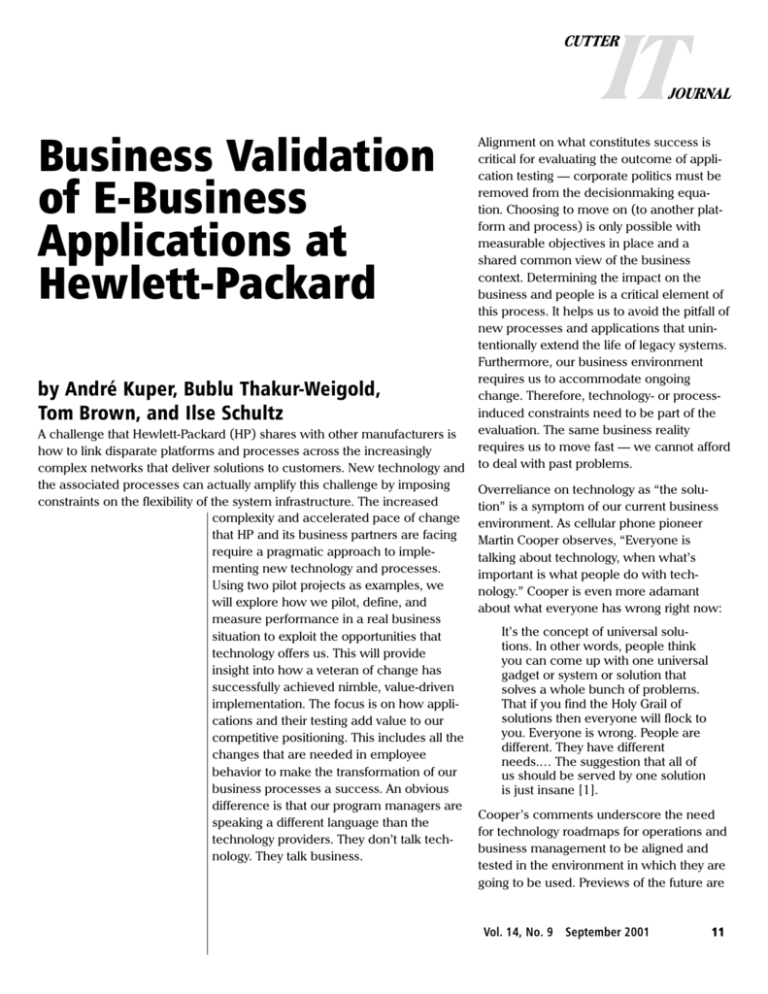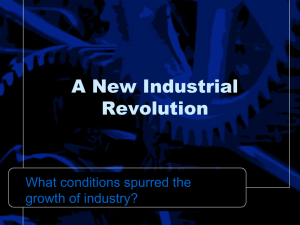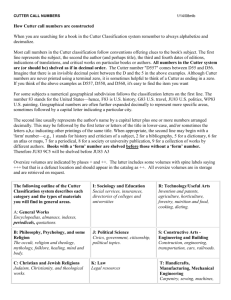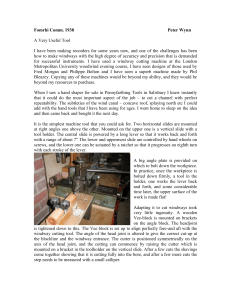Business Validation of E-Business Applications at Hewlett
advertisement

Business Validation of E-Business Applications at Hewlett-Packard by André Kuper, Bublu Thakur-Weigold, Tom Brown, and Ilse Schultz A challenge that Hewlett-Packard (HP) shares with other manufacturers is how to link disparate platforms and processes across the increasingly complex networks that deliver solutions to customers. New technology and the associated processes can actually amplify this challenge by imposing constraints on the flexibility of the system infrastructure. The increased complexity and accelerated pace of change that HP and its business partners are facing require a pragmatic approach to implementing new technology and processes. Using two pilot projects as examples, we will explore how we pilot, define, and measure performance in a real business situation to exploit the opportunities that technology offers us. This will provide insight into how a veteran of change has successfully achieved nimble, value-driven implementation. The focus is on how applications and their testing add value to our competitive positioning. This includes all the changes that are needed in employee behavior to make the transformation of our business processes a success. An obvious difference is that our program managers are speaking a different language than the technology providers. They don’t talk technology. They talk business. Alignment on what constitutes success is critical for evaluating the outcome of application testing — corporate politics must be removed from the decisionmaking equation. Choosing to move on (to another platform and process) is only possible with measurable objectives in place and a shared common view of the business context. Determining the impact on the business and people is a critical element of this process. It helps us to avoid the pitfall of new processes and applications that unintentionally extend the life of legacy systems. Furthermore, our business environment requires us to accommodate ongoing change. Therefore, technology- or processinduced constraints need to be part of the evaluation. The same business reality requires us to move fast — we cannot afford to deal with past problems. Overreliance on technology as “the solution” is a symptom of our current business environment. As cellular phone pioneer Martin Cooper observes, “Everyone is talking about technology, when what’s important is what people do with technology.” Cooper is even more adamant about what everyone has wrong right now: It’s the concept of universal solutions. In other words, people think you can come up with one universal gadget or system or solution that solves a whole bunch of problems. That if you find the Holy Grail of solutions then everyone will flock to you. Everyone is wrong. People are different. They have different needs.… The suggestion that all of us should be served by one solution is just insane [1]. Cooper’s comments underscore the need for technology roadmaps for operations and business management to be aligned and tested in the environment in which they are going to be used. Previews of the future are Vol. 14, No. 9 September 2001 11 speculative at best, whereas existing investment and resource constraints set boundary conditions for strategic and operational direction. It is all about people and the way people work. HP has a history of learning by doing, testing several aspects simultaneously, to allow fast and precise direction changes. They can provide an excuse for continuing poor processes or adopting technology that does not fit the need. OUR APPROACH TO IMPLEMENTING NEW TECHNOLOGIES AND PROCESSES To get to more realistic expectations for technology and applications in particular, we must appreciate the businesses environments that use them. Therefore, starting with the business needs is crucial. These challenges provide the framework for technology selection based on a representative pilot that measures performance in the environment in which the application will be used. Following is an action-oriented framework that helps us do just that. Define the burning platform. “What is the compelling reason for change?” is the fundamental question that needs to be answered before making any meaningful change in processes and application environments. We need to face the reality that forces us to change the way we work, because doing nothing, continuing the way we work now, is not a realistic option. Create alignment. Now that we have established a business reason for change, we need to ensure that everyone understands why he or she needs to get involved. The change will impact everyone’s behavior. Moreover, early involvement of all stakeholders prevents mistakes and delays later in the process. Identify performance gaps. With the context for our project or initiative in place, we need to understand and measure our current performance in light of how we 12 September 2001 Vol. 14, No. 9 should perform. This performance gap provides guidance for measurable objectives. Performance is a result of people’s behavior, and our organizational structure and incentives drive this behavior. Unearth assumptions. One of the critical success factors is making our assumptions visible. These assumptions — when not known and therefore not validated or disproven — are a major barrier to success. They can provide an excuse for continuing poor processes or adopting technology that does not fit the need. A perfect example is the assumption that if people do not do what is required, they need to be educated. Behavior is primarily a result of structure and metrics, not necessarily of knowledge and skills. Therefore, the assumptions of both management and employees need to be known and clarified. Discover existing knowledge. Intellectual capital, especially tacit knowledge about processes and dynamics of the supply chain, is a critical competitive advantage. Displacing this knowledge by forcing a new process not only does a disservice to the employees involved, it also destroys an opportunity for positive involvement of your stakeholders. We start with what people know to reduce our implementation time and to eliminate sources for disconnect or missed opportunities. Define metrics. The burning platform, performance gaps, assumptions, and existing knowledge form the basis for setting measurable objectives. They way we measure our project or initiative’s performance must provide a balanced scorecard. That is, it needs to provide measures that allow us to make tradeoffs. For example, cycle time needs to be balanced with yield, and inventory needs to be balanced with our performance in the eyes of the customer. ©2001 Cutter Information Corp. Qualify pilot. Selecting where we are going to test and measure new technology is as important as why and what we are going to validate. Issues we need to consider include how well the results can be generalized, complexity that can create leverage in the future, the readiness of all involved to act, and sponsorship. Define processes. Specifying what processes are affected and which processes are going to be used is extremely important. This is the real value of any application implementation, and it is where competitive differentiators are maintained. Furthermore, it provides a safeguard against politically motivated decisions. Change people’s behavior. A major pitfall is getting people excited about a new way of doing things and then failing to deliver. What is important is whether people actually positively change their behavior. If they revert to the old ways, the new process has failed to overcome the most fundamental objective. This requirement includes how people’s performance is evaluated, how the structure of the organization enables and supports them to change, and ongoing dialogue. Change does not happen in a vacuum; it requires careful and elaborate management. This aspect of application implementation [and the preparation] will consume more than 80% of the time and resources. Test under realistic conditions. Many applications make assumptions about how the users will interact with the system. We find two characteristics to be critical: ease of use and scalability. Often applications fail to address the workflow of their users or make implicit process assumptions that create negative user experiences. Often vendors (and, unfortunately, business managers) believe training solves problems caused by poor usability and application complexity. For their part, users are very creative in finding new ways of using applications that do not match the developers’ intentions. This frequently results in application loads that were not anticipated. Unexpected application loading can be a major inhibitor of scalability. For example, system access problems can result from higher-than-expected server requests when users adopt secondary functionality as the engine for their critical processes. Similarily, programmers often underestimate the complexity of business processes and impose limitations that actually negate potential gains. Immersing vendors or IT professionals in the business environment during testing is a proven strategy. For the pilot manager, it adds another benefit: he or she is not the intermediary for user gripes and vendor justification. Immersing vendors or IT professionals in the business environment during testing is a proven strategy. Expand use. Making choices is what a correctly positioned and executed initiative is all about. Rolling out an application is not about bolting on new modules, adding new business units, or increasing the number of partners, it is about evolving processes and making tradeoffs in the course of action. As there is no one-size-fits-all solution, appreciation for the diversity in processes and behaviors needs to drive technology adoption. Move on. If a technology or application does not meet our business objectives, we need to replace it and move on. Best of breed or best of class are meaningless in our business environment, which undergoes rapid and relentless change. Does an application accomplish what we intended? Did we unearth technology limitations that unduly burden our employees? Are the process modifications limiting our flexibility? Is the return on investment high enough? This pragmatic approach to technology is urgently needed. In our desire to keep up Get the Cutter Edge free: www.cutter.com/consortium/ Vol. 14, No. 9 September 2001 13 with the latest technology, we forget that being hip doesn’t guarantee business success — as the current business climate illustrates. However, this healthy skepticism of technology for its own sake should not be allowed to prevent change when the business situation truly calls for a different approach. CASES IN POINT Anytime changes occur, they need to be documented and tested according to a rigorous requirements process in order to meet customer expectations. To illustrate our approach to implementing new technology and processes, we selected two pilots in which we transformed our existing processes to incorporate the Internet. Both e-business applications changed fundamentally in the process of implementation. We collaborated with the technology providers to transfer test results to application improvements. Moreover, we worked together to ensure that testing positioned HP’s unique process knowledge as complementary to the applications. The latter allows us to develop joint going-tomarket strategies with unique value to our customers. Implementing an Internet-Enabled Information Backbone The Burning Platform The telecommunications market is going through tremendous change in the way its infrastructure is set up and used. Users are looking for faster access and more comprehensive services. Telecom service providers are increasingly using third parties to provide the global data and voice network infrastructure. Finally, network equipment providers are in the midst of establishing standards in an environment of rapidly emerging technologies and shakeout. The business objectives are disparate: telecoms are looking for robust, long-lasting, and standardized infrastructure and debt load reduction; network deployment companies are 14 September 2001 Vol. 14, No. 9 looking for flexibility to meet future revenue opportunities; and equipment providers are trying to own the emerging standards and secure their future viability. Hewlett-Packard is delivering into this complex demand-side network. Lack of visibility of the global demand increases the business risk and requires more inventory to meet short delivery time expectations. Similarly, the global nature of e-business systems with different network requirements stresses the supply-side network. Technology discontinuity and long lead times provide additional challenges. Anytime changes occur, they need to be documented and tested according to a rigorous requirements process in order to meet customer expectations. To cope with technology churn, [lifetime buys] are the order of the day. All these forces create downward pressure on margins and profitability and increase the task load of the program managers. This task load reduces the number of programs they can work on and hence the revenue opportunities for HP. To meet and exceed growth and profitability objectives, HP’s Telecom Infrastructure Division (TID) needed to change its processes and collaborate with its up- and downstream partners. Visibility of the bidirectional information, material, and finance flows was a key requirement in achieving these goals. An upcoming platform change provided additional urgency. Discover Existing Knowledge TID started with exploring the existing processes, identifying owners, decisionmakers, transfer points (handoffs) of flows, inputs, outputs, and established practices. This allowed the quick creation and implementation of a representation of the supply chain flows. In the process, TID ©2001 Cutter Information Corp. immediately started to improve on them. The flow representation allowed members of the team to design the supply chain for the new platform with an understanding of the current dynamics. While expanding the view to the upstream and downstream partners, they discovered existing processes, behaviors, and systems that allowed an end-to-end supply chain view with little investment. This visibility drove collaboration. By sharing knowledge and having an Internet-based platform to do so, they started to build trust with their partners. Collaborative Processes The partnership involved not only internal and external supply chain partners, but also the application service provider, Global Factory. Visibility, we discovered, is a powerful driver for change. As we changed our expectations, relationships changed with them. We found that there’s no substitute for learning by doing when you’re implementing and testing an application. For example, we jointly worked on the layout of the user desktop when we found the sequence of user actions, the labels on buttons, and the interpretation of the data were hampered by their presentation to the users. We also discovered the quirks of Internet accessibility though different corporate networks; for example, we registered as a child-friendly site in order to penetrate the barriers companies had built to protect themselves against liability for Web-surfing employees. We started with the forecasting process, and it soon became clear that there were ways this process could be improved. The net result was a collaborative forecasting process that requires less time than the original internally focused approach. Similarly, the existing documentation in the two manufacturing locations allowed for tracking and tracing parts, yield, and quality issues, but now as a collaborative. This again eliminated significant amounts of time previously spent hunting down information, and TID became a better partner because of it. One of the major test insights was to accelerate data pulls from resident and legacy systems by exploiting their export capabilities. The ubiquitous desktop spreadsheet as formatter for data pulls eliminated IT involvement and shifted the information management power to the operations people. Rather than adding IT as an intermediary for translating information needs to system data pulls, we collaboratively identified default exported spreadsheet data elements to be transferred into the information backbone. This increases our flexibility to connect disparate systems and mitigates the risk of system lifecycles that are out of sync with our application’s lifecycle. We found that theres no substitute for learning by doing when youre implementing and testing an application. Define Performance The cost of labor in terms of the task load and ability to manage additional programs has a profound impact on learning curves and usability. On-the-job assimilation and the time needed to involve partners provide a benchmark for future rollouts and cost to the company, as well as providing guidance to our partner on support requirements. Firstly, it is very important to establish acceptable levels before the implementation and testing occur. Secondly, as not all of these costs will be transparent to our accounting systems, tracking and documenting actual performance are critical. As the information backbone to support a new platform became a reality, we started to eye the current platform. The downturn had a profound effect on our customer demand and the end-to-end supply chain flows. Being able to meet a 24-hour delivery window with lower costs of goods sold Get the Cutter Edge free: www.cutter.com/consortium/ Vol. 14, No. 9 September 2001 15 Without this testing, expansion of tool use would likely have generated user dissatisfaction and cost overruns by both partners. (COGS) gained urgency. We started to define performance in terms of the profit and loss of the system. Risk and reward sharing of all partners involved became an integral part of our view on the world. As we were preparing to roll out, we achieved a time-to-market reduction of two months, a collaborative forecasting process that reduced labor by four hours a week, and a process to track and trace flows. These improvements were achieved in just six weeks with very little investment. relying on only one option, spot markets, does not make business sense, as all electric power users in California can confirm. KeyChain, HP’s private exchange for supplyside collaboration, is a good example of a successful pilot of new technology. Although initially conceived as a proof of concept, KeyChain quickly became a driver for business transformation. Not only did this happen with high velocity, it also provided focus on how technology adoption itself should be collaborative. Test Under Realistic Conditions The drive for improved asset management has shifted our business environment from internally integrated supply chains to managing complex networks with contract manufacturers, third-party logistics providers, suppliers, and other highly specialized service providers. Managing these networks requires more than transactions. Some critical business needs on the supply side are purchase order collaboration, forecast collaboration, and event or exception management. These processes tend to be time-consuming and often result in delays. These delays increase costs: they add the need to buffer for uncertainty through increased inventory, create surprises that require overtime and [“nonrecurrent engineering,”] induce stock outs, or drive rework. Most of all, they shift the focus to reactive management of the supply network. HP’s Operations Procurement saw an opportunity to reduce these delays and reduce costs through a private exchange. In the process of populating the information backbone, we discovered the need for sampling and archiving information for further analysis. Our initial assumption of real-time visibility as a guide for action underestimated the accessibility to end-toend ERP and MRP information by operations professionals. Furthermore, having a single workspace for all their activities excited them. This drove some database architecture innovations that were outside the scope of the original pilot but greatly increased the value to the users. Similarly, users were up- and downloading multiple large files, uncovering file management needs for the tool and network bandwidth limitations within the company. Without this testing, expansion of tool use would likely have generated user dissatisfaction and cost overruns by both partners. Furthermore, user perceptions and behavior are powerful agents in enhancing real business benefits. Piloting a Private Exchange: KeyChain Face Reality As many of Hewlett-Packard’s procurement processes address complex information, material, and financial flows in partnership with suppliers, public environments have limited impact on our business. Furthermore, from a risk management perspective, 16 September 2001 Vol. 14, No. 9 Translate Vision to Value The first step was a proof of concept. KeyChain commenced as a start-up within HP with seed money and set deliverables. Apart from testing and validating the technology and process assumptions, KeyChain needed a business sponsor to apply and test its concept. That is, it needed to create alignment on action in the context of a crit©2001 Cutter Information Corp. ical business need, a “burning platform.” The start-up’s first business sponsor was manufacturing operations in Puerto Rico. Government incentives facilitated this match. The sponsorship and funding were key enablers for success and provided the direction for action (hence velocity, not just speed). The value perceived by the business was in exception management and contract negotiation. Although the business unit was looking to automate standard processes that added little value, enabling event-driven collaborative purchase order management with alerts was of most value. This was different from the transaction management the start-up thought to be its core competency. In the process of working with its sponsor, KeyChain moved from discrete order process management to supply-side collaboration. Similarly, the change in business model drove this emerging business from exploring a technology opportunity to having customers involved in its growth. This involvement translated into measurable objectives: improved responsiveness measured in reduced cycle time, reduced error rate measured in reduced task load, and visibility measured in time spent on the relationships. Moreover, the impact on COGS ensured the linkage between strategic and operational objectives. Build Strategies Now that a first customer was involved, further expansion needed to be considered. A major pitfall for all organizations deploying new technologies is the heavy, and sometimes debilitating, impact powerful first customers can have on the structuring and deployment of technology and processes. By extending the sponsorship and involvement to the supply chain council that represents our operations management interests and the executive council that represents our strategic interests, this risk was mitigated. As these groups also provide funding, they are in a position to guide KeyChain through emerging business challenges and opportunities. Furthermore, they provide a platform for sharing evolving intellectual capital. They help determine which suppliers, contract manufacturers, thirdparty logistics providers, and parts or subassemblies to focus on. This approach provided a competitive differentiator that sets KeyChain apart from its competitors, who also started with a transaction focus but evolved much more slowly to include the value-added services our business units were looking for. Interestingly, the involvement of these different decisionmakers also clarified the flexibility e-business applications can offer.1 By describing the role of public2 and private exchanges in detail, managers have clear choices in mitigating business risk. Testing this application in a business environment unearthed more than technology and process. It challenged assumptions about business strategy and customer value. Working with keychain’s business partners, first Puerto Rico Operations then the supply chain council, proved to be a great enabler for functionality, use, and specifying the test environment. It also invited Operations Procurement and KeyChain to rethink their relations within the supply chain network. That transformation provided guidance for further testing and rollout in HP. Learn by Doing Focusing on processes and people is critical to driving application characteristics like platform robustness, program infrastructure, deployment, and support. The process and relationships provide the competitive advantage enabled by the application. They also allow us to be pragmatic: if a partner is Get the Cutter Edge free: www.cutter.com/consortium/ 1 See, for example, “Supply Chain Strategy: Real Options for Doing Business at Internet Speed,” in Achieving Supply Chain Excellence Through Technology II. Montgomery Research, 1999. 2 One example is Converge, a result of a similar pilot, TradingHubs, discussed in André Kuper, “Implementing E-Business Strategy to Create Flexibility and Velocity,” Cutter IT Journal, Vol. 14, No. 5 (May 2001), pp. 5-11. Vol. 14, No. 9 September 2001 17 André Kuper works with internal and external experts to define business models incorporating the power of the Internet. He creates supply chain communities, balancing the need for personal contact, access to information, and action. Mr. Kuper collaborates with a multitude of partners to define business webs driven by customer needs for small business, consumer, and major account segments. He focuses on velocity, volatility, and flexibility. Mr. Kuper holds master’s degrees in applied physics and instructional design from The University of Twente (UT), The Netherlands. Bublu Thakur-Weigold has worked with the logistics modules of SAP software for over 10 years, the first 5 of which she spent at Andersen Consulting. Since joining Hewlett-Packard Consulting in 1995, she has performed in various project roles, ranging from design and implementation to process analysis and modeling, project management, and the management of change. Ms. Thakur-Weigold holds a bachelor of science degree in management science from M.I.T., with a specialty in operations research. already part of another marketplace, we enable linkage. This allows us to test the application in a heterogeneous environment and provides a benchmark with a similar application. However, we cannot be everything to everyone. Therefore, when merging disparate architectures, the business objectives and experience (unique intellectual capital) provide reference. If an application fails to support processes that were developed to meet unique business needs or requires unique code modifications, we need to select another application. Finally, we change the way people are working. If an application is not used because it fails to meet critical user needs, it has no business impact and needs to be discarded in favor of an alternative. Similarly, if an application facilitates business as usual, the return on investment will be absent. For example, one of our partners used documents to drive its business processes. Moving to a Web-based environment was a profound change. This provided a stringent litmus test for the application capabilities; would this company adopt the new processes and use the Internet? This may sound mundane, but it illustrates how seemingly simple aspects of how people manage their business can enable change or be a major barrier to performance improvement. Test Under Realistic Conditions Testing in defined relationships where alignment is a prerequisite for operational excellence made a difference. KeyChain achieved a 50% cycle time reduction for its sponsor. This had a major impact on contract negotiations and business continuity. The number of errors was significantly reduced by moving from manual to automated processes. This proves the need for testing an application where it will be used and by whom it will be used. KeyChain 18 September 2001 Vol. 14, No. 9 testing increased the value contributed by the buyers and procurement coordinators, the real users. Their role shifted from crisis management and tedious processes to relationship management, while reducing their task load by 30% and 40%, respectively. Their adoption of KeyChain and its process automation provided the business case for rollout. Allowing partners to manage inventory and to connect to our IT backbone required more than a technology fix — it changed the way people worked. These realistic conditions and the business value remove politics from the decision to continue or move on. For example, purchase order collaboration differs from the existing procurement process. Does KeyChain add complexity or value? Similarly, aggregation, complexity, and replenishment planning start to change people’s jobs. Does KeyChain facilitate this change or is it a barrier? The test of intangible value centered on process changes and integration by choice. KeyChain passed, and these benefits eventually will reduce COGS. Influence Performance Building a private exchange environment from scratch created the opportunity to change the way we work with our supplyside partners. Rationalizing our purchase order processes and creating a collaborative framework were very different from plugging and playing an e-business application. The technology functioned as an enabler for business change in Hewlett-Packard and its supplying partners. By making the technology subservient to the business goals and involving different layers of our enterprise in the implementation and testing process, we exploited the opportunity to incorporate the Internet in a portfolio of applications to manage the supply risk to our enterprise. ©2001 Cutter Information Corp. CONCLUSION To implement e-business applications is to transform a business. It requires a strategy, a common understanding of why it makes business sense, and a robust process to make decisions. These decisions are tradeoffs. They need to balance business needs and application capabilities. Testing applications requires testing functionality under real business conditions with business results as the measure. Moreover, implementing e-business applications is about changing people’s behavior and providing an organizational and incentive structure to make this behavioral change a success. If the application fails to contribute to the way people work or perpetuates existing poor practices, we should move on. The applications we discussed in this article are driven by business needs; however they differ in focus, velocity, and flexibility. They also differ in IT involvement in the testing. KeyChain is about procurement leverage and mitigating our supply risk. It involves significant capital investment and resource consumption. Furthermore, KeyChain demonstrates successful enterprise leverage of an internal investment. It provides common processes where they make sense, significantly reducing cost and increasing procurement value. Testing involved the roles and responsibilities of procurement specialists and buyers and required operations IT resources. e-service provider had to facilitate testing in its hosting environment and the users’ work environment. Exploiting existing systems and processes was key to allowing change. In both cases, disparate processes and systems were integrated and tested. In both cases, collaborative processes were an outcome. These successful examples illustrate how we at Hewlett-Packard constantly transform ourselves and adopt new technology by testing in a real business environment with a compelling reason for change beyond the application functionality. Applications are an enabler — not the change agents — for maintaining a viable business environment in an increasingly complex world. REFERENCE 1. “Everyone Is Wrong: Q&A with Martin Cooper.” Technology Review (June 2001), pp. 83-86. Tom Brown is a program manager in the Telecommunications Infrastructure Division’s Project Center. The Project Center is responsible for the development and adaptation of HP and thirdparty technologies for use as repeatable solutions in the telecommunications market space. Mr. Brown is responsible for the GSM Base Station Controller program, supporting 2G and 2G+, with investigations into UMTS/3G under way. The Base Station Controller provides the infrastructure for the computing and communications elements of the GSM solution, with the customer providing the application. Mr. Brown has been with HP for 6 years and previously worked for a large network equipment provider for 21 years. Ilse Schultz is the KeyChain program manager at HewlettPackard (HP). KeyChain is an HP private Internet marketplace that focuses on creating supply chain collaboration solutions for HP and its partners. Ms. Schultz has 13 years of experience in supply chain management and IT management in the high-tech industry. The information backbone is about visibility in a complex, volatile environment, where decisionmaking requires knowledge and collaboration to succeed. This pilot occurred in a business unit with little money, few resources, and unique requirements. Testing occurred with program managers, forecasting specialists, planners, and operations experts. No local IT resources were required, and the Get the Cutter Edge free: www.cutter.com/consortium/ Vol. 14, No. 9 September 2001 19






